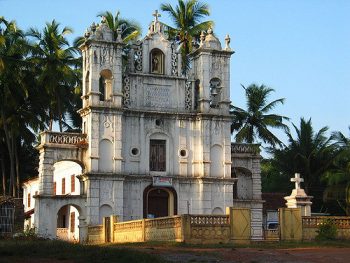Portuguese in Hindi (Part 2): A Tale of Trade, Travel and Cultural Tension Posted by Rachael on Jun 7, 2017 in Hindi Language, Uncategorized
Hello again, everyone! फिर से नमस्ते सब लोग/phir se namaste sab log or, as my Portuguese-speaking friends would say it, Olá de novo gente! That’s right, this week’s blog will be a continuation of where we left off last time: a discussion of the history and legacy of the Portuguese in India. If you missed last week’s blog, you can catch up here.
In 1509, Afonso de Albuquerque became the second Viceroy (or governor) in charge of Portuguese possessions in India; in order to ameliorate continued tensions (तनाव/tanaav, masc. noun) between the Portuguese and the Zamorin and preserve Portuguese interests in Malabar (India’s southwestern coast, which runs from the modern-day states of Karnataka to Kerala; तट/tat, masc. noun; a “coast along the sea” is expressed as समुद्र-तट/samudra tat), Albuquerque signed a treaty with the Zamorin in 1513. Subsequently, Afonso subdued the Bijapur sultans (a Shia Muslim dynasty that ruled Karnataka from 1489 to 1686) with the help of Timmayya (also known as Timoji or Timoja), a pirate of sorts who worked for the Portuguese as well as the Vijayanagara Empire (called the Kingdom of Bisnegar by the Portuguese, this was an empire based in the Deccan Plateau of South India and established in 1336). This enabled Afonso to create a permanent Portuguese settlement in Velha Goa (or Old Goa); not long after, the southern province of Goa became the headquarters of Portuguese India and the home of the viceroy. Besides Goa, you can see traces of Portuguese settlements and culture in Mylapore, a neighborhood in Chennai (Madras), where you can visit the Luz Church, first built in 1516; another church built by the Portuguese in 1522 through the destruction of the Kapaleeswarar Temple, a Shiva temple (मंदिर/mandir, masc. noun), is São Tomé (St. Thomas) church (in the same neighborhood).
After defeating (हराना/haraanaa, verb) and obtaining territory from the Gujarat Sultanate, the Portuguese’s Indian possessions comprised about 62 miles of the Western (पश्चिमी/paschimee, adjective) coast of India from Daman (Damão in Portuguese) to Chaul; the fortress town of Baçaim was responsible for overseeing these northern Portuguese possessions. As Goa became more established as the official seat of Portuguese rule in India, Europeans began to call it the “Rome of the East” and it was bestowed the same governing and administrative rights as Lisbon, the capital (राजधानी/raajdhaani, fem. noun) of Portugal. The Portuguese senate in India communicated with the Portuguese King directly and sent a special representative to his court.
Although once a Portuguese possession, Bombay or Mumbai was given to Britain in 1661 as part of Portuguese Princess Catherine of Braganza’s dowry (दहेज/dahej, masc. noun) when she wed (शादी करना/shaadi karnaa, verb) Charles II; later, the Marathas seized much of the Northern province in 1739 and incorporated it into their empire (साम्राज्य/saamraajya, masc. noun). Then, in 1843, the Portuguese capital in India shifted to Panjim, which was then named Nova Goa (New Goa), replacing the former capital of Velha Goa (Old Goa).
Subsequent to India’s independence (आज़ादी/aazaadi, fem. noun) in 1947, the Portuguese were the only colonial power that refused to give up its Indian possessions. In 1954, Indian individuals (व्यक्ति/vyakti, masc. noun) and organizations (संगठन/sangathan, masc. noun) such as the “United Front of Goans” and peaceful protestors following the teachings of Mahatma Gandhi (also called “satyagrahis” or सत्याग्रही; this word literally means “those who have an insistence on or zeal for the truth” but also refers to non-violent, political protesters or those who practice civil disobedience) tried to assert their rights to the territories, but they were met largely with violence (हिंसा/himsaa, fem. noun) from the Portuguese. Provoked by this brutality, India discontinued its diplomatic relations with Portugal. After a policy of “wait and watch” that was not successful in expelling the Portuguese, the Indian military invaded the Portuguese-held territories of Goa, Daman and Diu in 1961. Faced with India’s superior armed forces, including air and naval aide, the Viceroy of Portuguese India was forced to surrender, a momentous event that signaled an abrupt end to 450 years of Portuguese rule and presence in India. In 1987, Goa finally became the 25th state of the modern Indian nation.
Stay tuned for next week’s third and final blog in this series about different types of Hindi words and the influence of the Portuguese language on Hindi!
शब्दावली की सूची (Shabdaavali ki Soochi)/Vocabulary List:
- तनाव/tanaav (masc. noun): tension. Example sentence: अरे! तुम्हें इतना तनाव क्यों हो रहा है? क्या हुआ?/Are! Tumhe itnaa tanaav kyoon ho raha hai? Kyaa huaa? (Hey! Why are you so tense? What happened?)।
- तट/tat (masc. noun): coast. Example sentence: वीकेंड के दौरान, हम समुद्र-तट (समुद्र के किनारे is also possible) गए और वहाँ पे सारे दिन तैरे/Weekend ke dauraan, hum samudra-tat (samudra ke kinaare) gaye aur vahaan pe saare din taire (Over the weekend, we went to the beach (sea/ocean-coast) and swam there the entire day).
- मंदिर/mandir (masc. noun): temple. Example sentence: मेरी माँ चाहती हैं कि मैं हर हफ़्ते अपने परिवार के साथ मंदिर जाऊँ/Meri maa chahti hain ki main har hafte apne parivaar ke saath mandir jauun (My mother wants me to go to temple every week with my family).
- हराना/haraanaa (verb): to defeat or conquer. हारना/haarnaa, a related word, means to lose or to be defeated. Example sentence: मेरा दुश्मन मुझे हराना चाहता है/Meraa dushman mujhe haraanaa chahta hai (My enemy wants to defeat me).
- पश्चिमी/paschimee (adjective): Western. Example sentence: बहुत सारे इंदियन लोगों को पश्चिमी संस्कृती पसंद है और बहुत सारे पश्चिमी लोगों को इंदियन संस्कृती पसंद है/Bahut saare Indian logon ko paschimee sanskritee pasand hai aur bahut saare paschimee logo ko Indian sanskritee pasand hai (Many Indian people like Western culture and many Western people like Indian culture).
- राजधानी/rajdhaani (fem. noun): capital city. Example sentence: नई दिल्ली इंदिया की राजधानी है/Nayi dilli/New Delhi India ki raajdhaani hai (New Delhi is the capital city of India).
- दहेज/dahej (masc. noun): dowry. Example sentence: आजकल, इंदिया में दहेज माँगना ग़ैर-क़ानूनी है/Aajkal, India me dahej maangnaa gair-kaanuni hai (These days, demanding/asking for dowry is illegal in India).
- शादी करना/shaadi karnaa (verb): to marry. Example sentence: मेरा बड़ा भाई एक दिन एक मशहूर और सुन्दर अभिनेत्री/ऐक्ट्रेस से शादी कारना चाहता है/Mera baraa bhaai ek din ek mashoor aur sundar abhinetri/actress se shaadi karnaa chahta hai (My older brother wants to marry a beautiful and famous actress one day).
- साम्राज्य/saamraajya (masc. noun): empire. Example sentence: इंदिया के इतिहास में, बहुत सारे विदेशी लोग देश में आकर अपने अपने साम्राज्य स्थापित किए हैं/India ke itihaas me, bahut saare videshi logo desh me aakar apne apne saamrajya sthaapit kiye hain (In India’s history, many foreign people have come to the country and established their own empires).
- आज़ादी/aazadi (fem. noun): freedom, independence. Example sentence: १९४७/1947 में, इंदिया ने अँग्रेज़ों से अपनी आज़ादी प्राप्त की/1947 me, India ne angrezo se apni aazaadi prapt ki (In 1947, India achieved/obtained its independence from the British).
- व्यक्ति/vyakti (masc. noun): individual, person. Example sentence: हर एक व्यक्ति का अपना अनोखा व्यक्तित्व है/Har ek vyakti ke apne anokhe vyaktitva hai (Each person has his/her own unique personality).
- संगठन/sangathan (masc. noun): organization. Example sentence: लोग जो दूसरे देश यात्रा करके वहाँ अपने घर बनाते हैं, वे अक्सर सांस्कृतिक और/या धार्मिक संगठन बनाते हैं ताकि उनको अंजाने देश में भी घर पर होने का मेहसूस हो सके/Log jo doosre desh yaatraa karke vahaan apne ghar banaate hain, ve aksar saanskritik aur/ya dhaarmik sangathan banaate hain taaki unko anjaane desh me bhi ghar par hone kaa mehsoos ho sake (People who travel to another country and make their homes there often form cultural and/or religious organizations so that they can feel at home, even in a strange/unknown country).
- सत्याग्रही/satyaagrahi (masc. or fem. noun): peaceful protestor. Example sentence: इंदिया की आज़ादी से पहले, बहुत लोग अँग्रेज़ों के विरुद्ध (शांति से) सत्याग्रहियों के रूप में लड़ते थे/India ki aazaadi se pehele, bahut log Angrezon ke viruddh (shaanti se) satyaagrahiyon ke roop me larte the (Before India’s independence, many people fought (peacefully) against the British as satyagrahis (peaceful protestors).
- हिंसा/hinsaa (fem. noun): violence. Example: महात्मा गांधी को हिंसा पर विश्वास नहीं था/Mahaatmaa Gandhi ko hinsaa par vishvaas nahin thaa (Mahatma Gandhi did not believe in violence).

Build vocabulary, practice pronunciation, and more with Transparent Language Online. Available anytime, anywhere, on any device.






